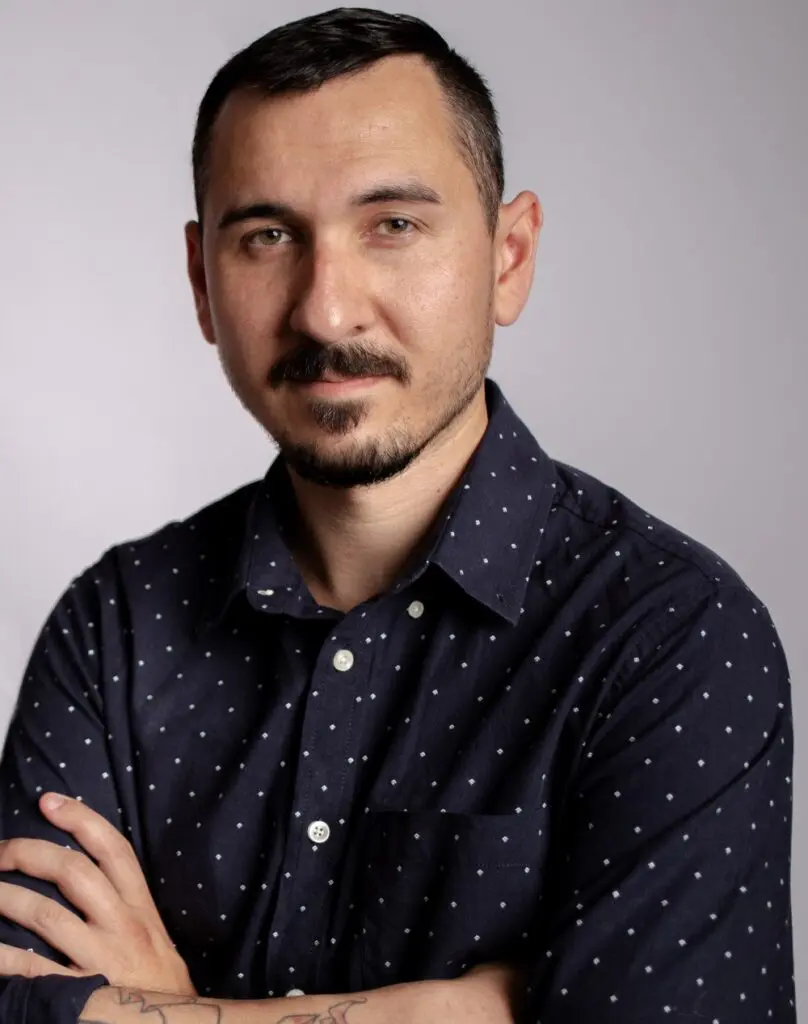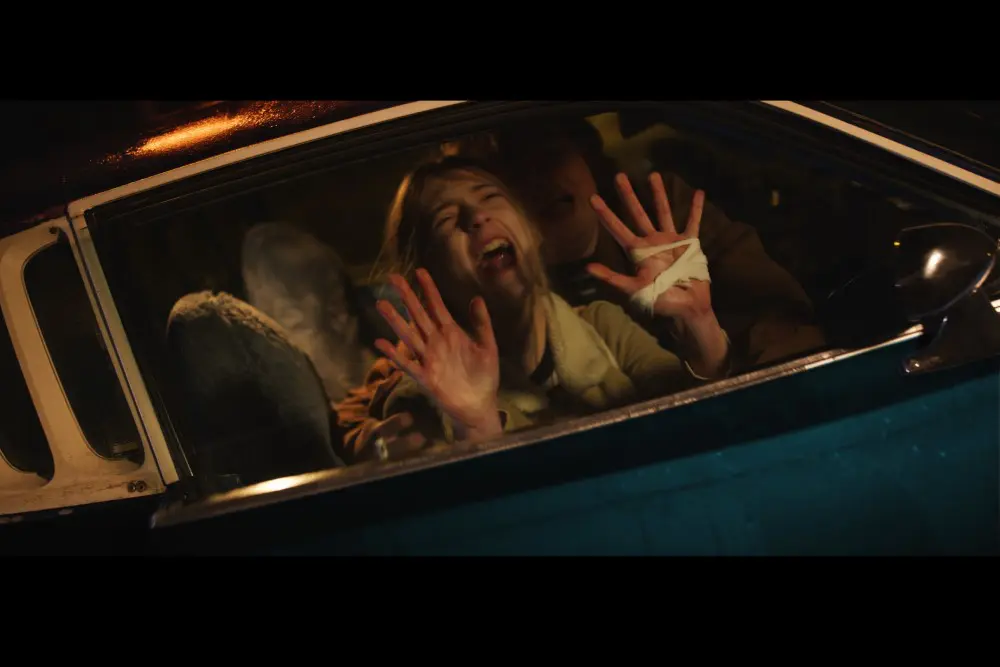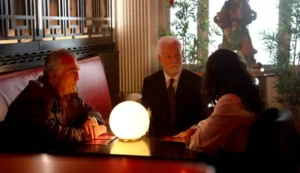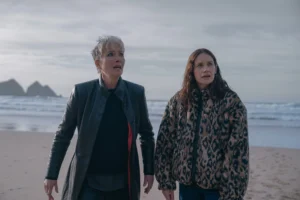They Reach is a low-budget, nostalgic adventure horror film. It harks back to films some of us may have grown up with, about youngsters who save the day against evil (such as The Gate and Phantasm) and is largely set in 1979. This will be one of this year’s world premieres at Grimmfest when it screens next month, and I had the good fortune of an interview with three of the people involved: Sylas Dall, writer/director; Bry Troyer, writer/producer; and Mary Madaline Roe (the youngest person I’ve spoken to this week), who plays the central character, Jessica Daniels.
Having had the privilege of a sneak preview, I opened the video call by commenting what fun They Reach must have been to make. Sylas Dall nodded: “It was. We have really good memories of making it. Every time we get together, we say oh man that was so much fun.” Mary Madaline even called it “the best time of my life.”
“So are you itching to do it again?” I asked. “Oh yeah, we’re already starting on the next one,” replied Bry Troyer, so evidently, the collaboration worked. Both Sylas and Bry had written the film, with one directing and one producing, though both had had some directing experience before. I asked how did they decide who should direct, and who came up with the story. Sylas explained that the idea originally arose for a short film festival, and it took off, so he wrote an outline for a longer story. When he first met Bry, he gave him that outline to glance over and he responded with enthusiasm, offering to give it some notes and feedback: sure, agreed Sylas, as long as you’re honest, and he was. Bry “gave it a rewrite” and thus the writing partnership was formed.
I had to ask: “What made you decide to set it in 1979?” Both the writers laughed, seemed a little embarrassed, and Sylas gave the obvious answer: “I really hate cellphones in movies. I grew up with older, classic films like Poltergeist, The Fog, the original Halloween, Big Trouble in Little China; a lot of films that felt spooky and adventurous. The Goonies, Close Encounters of the Third Kind, and all these others that just looked beautiful. I came from an artistic background, I draw and paint and I’ve done that all my life, I used to do comic books when I was younger. I loved the rich colors, the set designs, and wardrobe and everything of that era. I just kind of got stuck in it. Some of my other films, my shorts revolve in that era.” Having been born early in the seventies myself, I was able to tell them They Reach certainly looked and felt right to me.
I remarked on the popularity of retro films in the genre market and wondered why is it the seventies and eighties especially that pop up such a lot? Bry commented that even shows and films set in the current time have a “vintage feel”. “Things like Sabrina, they are driving in a car that looks like it’s from the eighties and then they pick up a cellphone. It’s interesting that we’re looking back on those days.” Sylas added that that period “holds a special place, especially for horror films. They have a classic nostalgia they like to feed into. So James Wan’s The Conjuring, set before Stranger Things, and I remember watching that about when I was writing our script, and I love the color palates from that era, I love the wardrobe. It immediately puts me back to watching something when I was younger, with this creepy aesthetic that felt so cool. It’s hard to do now, you have all this technology. And once the technology becomes so high, it’s like how do you isolate a group of kids or whatever, when everything is at their fingertips. They can call ‘help me!’ on their cellphones, iPads, internet, whatever, and it can mess with the story to the extent that I’ll say let’s just go nineties or before, I don’t want to deal with anything future.” Bry seems to find this amusing: “He’s got this kind of Amish horror idea.”
As a Devil’s advocate, I suggested that this isn’t far off Luddite. It was lovely to see the playful banter between the two writers here, though: Bry clearly would like to play around with features (like cellphones) that Sylas wants to avoid, and they tease each other: perhaps pushing buttons can also be pushing boundaries.
I turned to Mary Madaline, who was just twelve when she started working on They Reach. I had read she had found acting in a seventies-set film kind of weird, so I asked was there anything she particularly liked. “I loved the style, and I also really love seventies and eighties music,” she said. “I’m really into the rock, like Def Leppard and ACDC, kind of in that phase right now.” Sylas added that it was fun seeing how the kids in the film reacted to music by ELO that featured in one scene.
My son is thirteen, and he acts in a local theatre group, so I cheekily asked Mary Madaline if she had any advice as an actor that I could pass on to him. “Listening and reacting are really important,” she said. “Sometimes it’s not about your line, it’s about what the other person is saying. And subtlety is more important than going big: the camera is going to pick up on your little movements, nuances, and so on.”

I asked Sylas if he found it difficult working with kids; there were other issues to manage after all, like the budget. “The low budget takes the cake. It was ridiculous. I’m just a giant kid, myself. They’re like running around covered in blood, confronting this demonic entity, and I’m right there with them. I yell stuff like ‘let’s have you run through the door like this!’ and I’m showing them what to do like I’m one of them, a giant child when it comes to filmmaking.” Mary Madaline confirmed this: “Sylas is certainly a real actor’s director.”
There is a blend of teenage adventure with grown-up horror in They Reach, and I asked Sylas how – as director – he managed that line. “Bry and I talked about this a lot. It is a tricky line to walk, having comedy contrasting with scarier moments, you know, gives it a little bit of levity. We had multiple conversations: it is tricky and we went with our gut instincts, asking each other would it be fun for an audience overall at the end of the day to watch it? Is it fun, is it a rollercoaster? Trying to put yourself in the audience’s perspective is where Bry and I live: would we enjoy this, as a kid adventure?” Bry added “it was definitely more disturbing than a typical young adults’ film. It had just come out, and we were wrestling with the question of whether it should have so much blood and violence. We didn’t really want an R rating, but we decided to go ahead and put everything in. We’re targeting high schoolers, young adults, who would want to see that, and they’d probably be watching with their parents.”
There have been comparisons with Stranger Things in some of the publicity, so (like the last two interviews) I naturally asked how the writers felt about that. Sylas said “it was interesting to be lumped in with Stranger Things, which is flattering, to be honest. We made this for such a low budget, and we’re being compared with something that took multi-million dollars. It’s pretty cool. But then again, just like Stranger Things, Stephen King’s It, and all these other movies recently that pay homage to generations before them, that those directors and writers grew up with. And that’s where we began. Frustrating isn’t the correct word, but sometimes it’s unfortunate when we get into that territory of ‘oh you’re just another Stranger Things’ and stuff. That’s what it is.”
Bry credited this to a marketing group they had used: “They went all Stranger Thingsy on us. And we weren’t expecting that. It got out into the universe then.” Sylas added, “if someone puts something on the internet that you don’t approve of, well you’ve kind of got no control over that.” Bry didn’t seem to have any bad feelings about that marketing angle: “in likening our film to that, they were complimenting it. But when the word went out, people seemed to think we were mocking the show and we aren’t at all. We’re not riding their monetary coattails.” They’re looking forward to sharing the approved poster and publicity materials to accompany the wide release of They Reach in a couple of months.
I turned back to Mary Madaline: this was her biggest role to date and I asked whether she would like to stick with horror. “I think horror is a lot of fun and I would like to branch out and try new things. But I think my talents lie in the field of drama, not specifically horror. I’m looking for more opportunities to act in film and bring other people’s stories to life. I act not because I want to be famous, but because I love connecting with characters.“
We talked briefly about the variety that horror covers, which led to my particular appreciation of variety that is to be found in film festivals. “I miss those days, can’t wait for this COVID to be over,” said Bry, “virtual festivals just aren’t the same.”
“It’s definitely sucky,” agreed Sylas. “In person is definitely better.” They both love attending festivals, meeting other filmmakers, and talking about what they’ve seen. But they’ve all managed to carry on working in recent months: Sylas has been contracting in post-production, movie posters, and more recently marketing for an esports company. Bry hinted at two other projects they are also working on together, and hopefully as soon as the health climate changes, they can get back to it. One of these is sci-fi comedy, the other horror-comedy, “steering towards the Edgar Wright style of sharp and witty comedy.”
They Reach will be screened on 8 October. Perhaps it’s ironic that They Reach will have its world premiere online, yet it celebrates a time without such technology.




